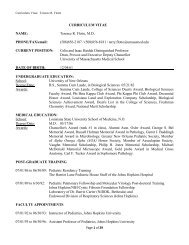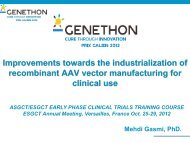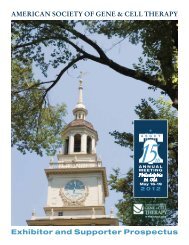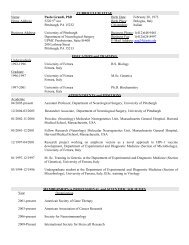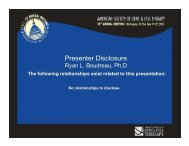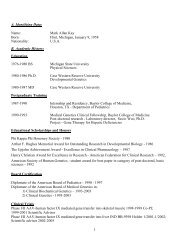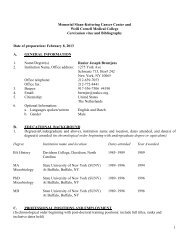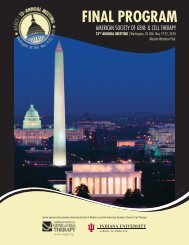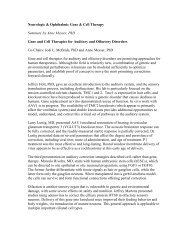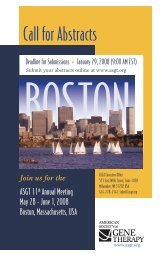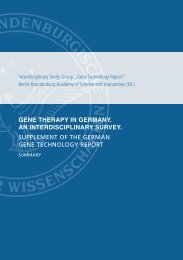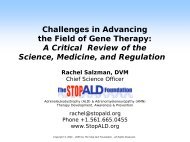Final Program - American Society of Gene & Cell Therapy
Final Program - American Society of Gene & Cell Therapy
Final Program - American Society of Gene & Cell Therapy
Create successful ePaper yourself
Turn your PDF publications into a flip-book with our unique Google optimized e-Paper software.
<strong>Program</strong> Schedule, Wednesday, May 15, 2013<br />
Wednesday, May 15, 2013<br />
in historical context. Robust life-long phenotype correction has been achieved in adult mice after single dose treatment with AAVbased<br />
vectors, and the translational challenges <strong>of</strong> moving towards clinical trials involving pediatric patients are currently being<br />
addressed. These challenges include targeting the developing liver where hepatocellular proliferation leads to loss <strong>of</strong> episomal AAV<br />
vector genomes and, depending on the therapeutic context, the possible need for vector re-administration to maintain effective<br />
levels <strong>of</strong> transgene expression.<br />
Stephen C. Strom, PhD<br />
Placental Stem <strong>Cell</strong> Treatment <strong>of</strong> Liver Disease<br />
Epithelial cells isolated from human amnion (hAE) have surface marker and gene expression proiles <strong>of</strong> pluripotent stem cells.<br />
Our previous studies have shown that hAE mature liver genes when transplanted into the liver <strong>of</strong> mice. Accordingly hAE were<br />
transplanted into the liver <strong>of</strong> iMSUD –mice, a useful model <strong>of</strong> the Maple Syrup Urine Disease. While untreated animals died at<br />
weaning, treated animals survived and thrived on a normal protein diet out to adulthood and showed signiicant correction <strong>of</strong><br />
amino acid and neurotransmitter proiles. These results suggest that hAE cells could be a useful cellular therapy for metabolic liver<br />
diseases.<br />
Alessandra Bifi, MD<br />
Phase I/II Clinical Trial <strong>of</strong> Hematopoietic Stem <strong>Cell</strong> <strong>Gene</strong> <strong>Therapy</strong> for the Treatment <strong>of</strong> Metachromatic<br />
Leukodystrophy<br />
Amit Nathwani, MD, PhD<br />
AAV Mediated <strong>Gene</strong> Transfer for Hemophilia A<br />
We have developed distinct approach for gene therapy <strong>of</strong> haemophilia A using adeno-associated virus (AAV) vectors which is based<br />
on our successful strategy for gene therapy <strong>of</strong> haemophilia B. Data from our preclinical evaluation will be presented together with<br />
an outline <strong>of</strong> Phase I/II trial design for Haemophilia A.<br />
Scientific Symposium 102<br />
8:00 am - 10:00 am<br />
ROOM: BALLROOM B<br />
<strong>Gene</strong> and <strong>Cell</strong> Therapies for Auditory and Olfactory Disorders<br />
CO-CHAIRS: Jodi L. McBride, PhD and Anne Messer, PhD<br />
SPEAKERS<br />
Jeffrey R. Holt, PhD<br />
<strong>Gene</strong> <strong>Therapy</strong> Strategies to Restore Sensory Function in the Inner Ear<br />
Sensory transduction in hair cells <strong>of</strong> the inner ear is the fundamental irst step that converts auditory information into electrical<br />
signals which are transmitted to the brain. Loss <strong>of</strong> sensory function in inner ear hair cells is the principle deicit in over sixty<br />
forms <strong>of</strong> genetic deafness. To investigate gene therapy as a strategy for restoration <strong>of</strong> auditory function our lab is focused on viral<br />
mediated delivery <strong>of</strong> wild-type Tmc1, mutations in which cause deafness in humans and mice. Tmc1 is expressed in hair cells and<br />
preliminary data indicated that AAV re-introduction <strong>of</strong> wild-type Tmc1 into hair cells <strong>of</strong> deaf mice can restore sensory transduction<br />
in vitro. Whether AAV-Tmc1 can restore sensory function in vivo is currently under investigation.<br />
Lawrence Lustig, MD<br />
AAV1-mediated Restoration <strong>of</strong> Hearing in the VGLUT3 Knockout Mouse<br />
Mice lacking the vesicular glutamate transporter-3 (VGLUT3) are congenitally deaf due to loss <strong>of</strong> glutamate release at the inner hair<br />
cell afferent synapse. Within two weeks <strong>of</strong> AAV1-VGLUT3 delivery, acoustic brainstem response (ABR) thresholds normalize, along<br />
with partial rescue <strong>of</strong> the startle response. Lastly, we demonstrate partial reversal <strong>of</strong> the morphologic changes seen within the<br />
afferent IHC ribbon synapse. These indings will be discussed and placed into the broader context <strong>of</strong> gene therapy for genetic forms<br />
<strong>of</strong> hearing loss.<br />
Jeffrey R. Martens, PhD<br />
<strong>Gene</strong> Therapeutic Rescue <strong>of</strong> an Olfactory Ciliopathy<br />
Olfactory dysfunction is a clinical manifestation <strong>of</strong> a growing class <strong>of</strong> human genetic diseases, termed ciliopathies. Despite<br />
substantial progress made in identifying genes that cause ciliopathies, therapies for these disorders are not yet available to patients.<br />
Here, we reported that odor detection can be restored to animals with a hypomorphic mutation in the gene encoding for the ciliary<br />
protein IFT88 that results in the loss <strong>of</strong> cilia on differentiated olfactory sensory neurons (OSNs). These studies represent the irst in<br />
vivo therapeutic treatment to reestablish cilia in a mammalian ciliopathy, and show that gene therapy is a viable curative option for<br />
functional rescue <strong>of</strong> the complex cilia organelle in established differentiated cells.<br />
32<br />
<strong>Final</strong> <strong>Program</strong> SALT LAKE CITY, UTAH May 15–18, 2013



